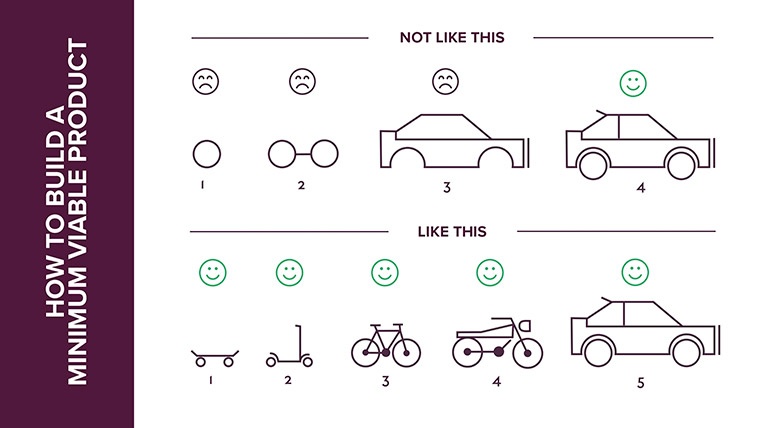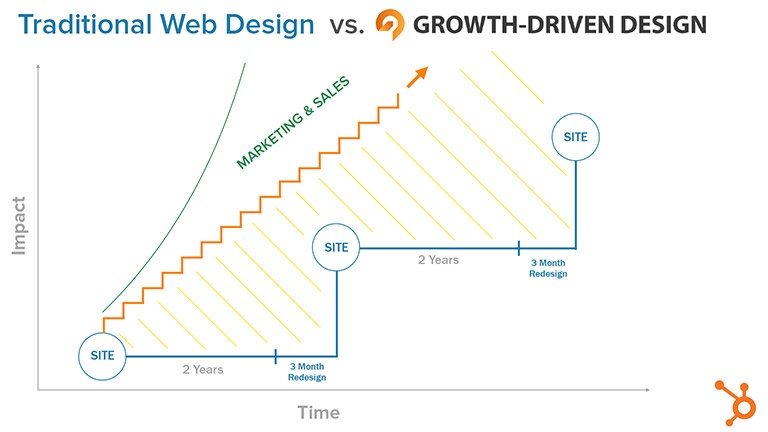Growth Driven Design: The sensible approach to B2B lead generation
Stop worrying about the cost and scope creep of a traditional website redesign and get on board with Growth Driven Design instead for your B2B website.

Isn't it weird how we design websites like we used to do print? Iteration after iteration sent back and forth between the agency and the client before the whole lot was shipped off to the printers with everyone's fingers crossed that when the finished article landed in the hands of the recipient. It was absolutely on message to the point at which they picked up the phone and placed an order right there and then. However there is a better, more sensible approach: Growth Driven Design (GDD). GDD can be deployed into any company size from small to enterprise, and to any site whether you're a startup or you've had a site online in one form or another for decades. The basics of Growth Driven Design are:
- Launch a website quickly and improve
- Investment is spread out over time
- Launch on-time and on-budget
- Data-driven decisions
- Month-on-month improvements
- Measure, iterate and act
In our modern digital age, where print is just seen as tree murdering, we have a much more flexible approach to marketing available to us via the world wide web, and yet bizarrely, we still follow a very similar pattern as we did with print, with a fire and forget approach to building and launching.
It's likely that if you work in marketing, you'll have been through as least one website design or redesign in your career. I'll give you a minute to get rid of that shudder... Yep, they're pretty painful aren't they? A huge investment in time and resources, large up-front costs for design and development, and when do they ever come in on time?
Scope creep
Everyone from the CEO to the tea lady throwing in their opinions as to how it should look and what content the pages should have. Little data led choices, just the highest paid person's opinion, made into a nice brochure site that sits there gathering dust and cobwebs for the next few years until you've recovered enough strength to have another go at yet another redesign.
Do you have a smartphone? Of course you do that's a stupid question. What also often seems daft is the number of times your apps decide they're going to update themselves. Seems like every other day you're prompted to update apps as they hurl another new menu or interface at you. Seems crazy right?
The thing is these behemoths of the tech industry have access to massive amounts or quantitative user data so they're constantly testing different interfaces and rolling out the most popular iteration to the end users once the winner has been decided on. They're constantly looking to improve the user experience of the engagement with the site to drive users to take the right route on their journey map. And let's face it, it keeps the customers happy and the dollars rolling in.
This lightweight, agile approach to website and app production keeps them ahead of the curve. They measure, hypothesise changes, test and implement before measuring again. This iterative process takes full advantage of the flexibility of code vs print, the chance to hone and perfect based on data and not on opinion. And it's not just the big tech giants that can take advantage of this process.
Startups suit Growth Driven Design, they're often light on content and can start with a clean slate, have a fully operational launch pad site that you can measure the results on the add to and change based on the data you receive.
But more established sites can take this approach as well. If you're looking to redesign the site you could enter into a 3 month plus project where basically you come up a prettier looking version of the site you already had but is just as ineffective, or you could go GDD and save yourself a massive amount of times and headaches.
No site redesign should ever be without a content audit, and because we don't want to throw the baby out with the bath water, it's important you take the time to assess the current status of your website in organic rankings so you don't tank your traffic when you move the site over to it's new look. But it's also important not to get bogged down with carrying over dead weight of pages that have no value for the sake of prosperity. The likely reason you've decided to go for a website redesign is because the current site doesn't generate enough leads, so your time is much better spent working out your personas, what their pain points are and what journey maps your site should have to help them locate the products and services you offer to solve those problems.
20/80
Use the 20/80 rule, 20 percent of the features that will create 80% of the impact. That's not to say you can't have all the features you want on the site eventually, but it's absolutely key you get a working site out there so you can start measuring the success and improving it.
What happens if you've recently undertaken a site redesign, has the horse bolted? Not at all! On the assumption you have a content management system there's not reason why you couldn't integrate Growth Driven Design into your new site. We specialise in WordPress and HubSpot CMS but we've found it is possible to integrate GDD into sites that are based on other CMS platforms such as Umbraco or even custom coded solutions.
So what are the stages of Growth Driven Design? There are three main stages: strategy, launch pad website and continuous improvement.
Strategy
This part is unequivocal, you have to have a plan, the roadmap for the purpose of the site that can be referred back to to ensure the team always has focus, you can set clear expectations and track/measure progress. If you've just launched a site you should already have this available, so you may be able to cut down on the length of this process but it cannot be skipped!
Launch Pad Website
If you've already got a slick, responsive, fast website already in the locker, great! If not, you can get a fully loaded site up and running in a much shorter period of time. A lot of people worry that this 'launch pad' site is just half a site and it'll launch with a load of holes that'll get filled in later. That isn't the case, the fluff and noise goes sure, this is about delivering a complete solution based on what we know so far, then through the process of measuring, drawing up hypotheses, testing and deploying the site evolves. Think of it along the lines of software development with a minimum viable product, no one ships something that doesn't work, they make sure the user has everything they need then iterate and refine going forward.

That doesn't mean you won't have a site that's isn't beautiful. We have a growing repository of modules we can rapidly tweak and redeploy on new sites, so the hard work of the design has already been completed, which means the time and focus can go into the actual content and getting the new site up and working and measurable!
Continuous Improvement
Once you have your site in place then the real work starts! And results! HubSpot is a great platform for measuring engagement with your visitors, but you can dig even deeper with qualitative, observational and quantitative testing provided by tools like Hotjar. You can heatmaps to pages which gives you an insight of not only how far people are scrolling down your pages, but where are they clicking and where are they hovering. You can also see individual recordings of your users to see actual session data as if you were looking over their shoulder. "Why didn't they click on the offer button? They seemed really engaged with the content, why didn't they take that next step? Is the text wrong? Maybe it doesn't look like a button?!" You'll be able to see patterns in conversion rate failures and correct them.
Time is often an expensive commodity for marketing departments, and the idea of having to work on the cornerstone pages of their website as well as giving their time and attention to other inbound marketing activities such as blogs and assets, could seem like too much to bear. A lot of the GDD mantra involves the Agile methodology, which could scare a lot of marketers having to take on the role of product owner as well as everything else they have to do. Happily though, whilst it's key the client has a close role with the team, because so much of this is data driven, your agency will be able to do all the work of studying the user feedback, make a series of recommendations as to what to change on the site, present the hypothese, work involved and so on, for you to sign off on.
Search Engine Optimisation
Turning to SEO for a moment, since the introduction of Google's Rankbrain algorithm, it's more important than ever to increase the engagement of your visitors on your website. Those key metrics of time on page, which needs to go up, and the bounce and exit rates, which need to go down, should be your focus now more than ever. You can't get the pages on your website right the first time around, it's just not possible, you have to measure and change to get them right. You may have a good idea of what your customers want. You may, and should, talk to existing customers about their experience with your site prior to engaging with you and learning from that, but your best results will come from that continuous improvement cycle.
Cost
This all sounds like a lot of work, so is it more expensive than traditional website design? No. And Yes. With traditional sites, you tend to pay a larger lump sum up front for the strategy work, and the design work and the development work. Because launch pad websites are supposed to be all the content and not so much of the design marathon, you should be able to save with that initial setup. The ongoing cost of having the agency measure and make iterative changes to the site can be done on a fast, faster and fastest basis to suit your budget. What you should see from each months work is an improvement in the conversion rate and therefore your ROI which will give you the confidence to not only continue with the process, but to get the agency spending even more time to increase the optimisation of the site to really delight your visitors and super charge the number of quality leads it generates.
And remember, with all this data-driven change constantly evolving the site to be the best it can be, you may never need to redesign your site ever again. If you want to ensure your website redesign stays on track, download our free B2B website brief template to map out all aspects for your project.
 Paul Marshall
Paul Marshall

